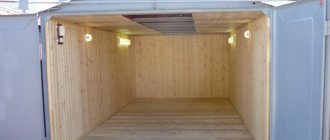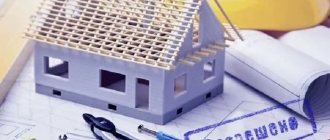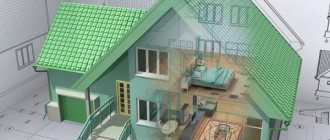To build a house, you can use the mortgage lending program. Most large banks in the country have such offers.
Under what conditions can I get a mortgage for building a house? Which banks should I contact? And in what case is a potential borrower most likely to be refused? Real estate investment expert, head of the real estate agency Andrei Mozol these questions to the FAN .
From the personal archive of Andrei Mozol /
Preparing for a mortgage to build a house
Before contacting the bank, it is important to resolve several “formal” questions about where construction is planned and in what form. Banking organizations do not support any type of construction: as a rule, loan funds are provided for individual housing, that is, for the construction of a private house or cottage. Some programs are designed for the construction of “seasonal” housing, that is, country houses, summer houses.
One of the main requirements for compliance with these programs is the selection of a land plot with a similar purpose. That is, if a potential borrower applies to a bank for a mortgage to build a private house, he will have to submit documents for a plot of land with a designated purpose “for individual housing construction.” If he plans to lend under a program for the construction of suburban housing, the intended purpose of the land may be different: for private plots or gardening.
There are categories of sites on which the construction of residential buildings is prohibited. And asking for money from a bank if construction is planned on such land does not make sense. Such areas include lands:
- industry;
- water and forest resources;
- specially protected areas;
- stock.
It is also prohibited to build residential buildings in agricultural areas, but with a caveat: it is possible to build a seasonal house here if the land is used for personal farming.
Therefore, when choosing a site, it is important to choose it taking into account its intended purpose. You can clarify the category of land, as well as restrictions on the site, in Rosreestr by submitting an application at the nearest one or online on the website.
Nuances of choosing technologies and materials
At the design stage, a technology and wall material are selected that will meet the construction budget and the do-it-yourself execution mode. When choosing materials, they are guided by their specific properties and the pace of construction - if frames or wooden log houses are assembled in winter, then laying bricks or various blocks should be delayed until the warm season. When construction is planned in stages over several years, it is important to select a technology in which the box will overwinter without a roof, without losses, and will stand quietly for several more years without heating.
If you intend to purchase and long-term storage of building materials in order to save money, you should pay increased attention to storage conditions and shelf life. After its expiration, building mixtures lose a significant part of their properties, even if they do not petrify due to high humidity. Usually the terms and conditions are specified in the instructions, which they mistakenly do not consider necessary to comply with, and then they blame them for poor quality, although the mirror shows the culprits. Plus, you shouldn’t be fooled by suspiciously low selling prices, as in everything, miracles are rare in construction and good quality almost never goes in tandem with cheapness.
Today, the private sector is represented by several popular types of houses.
Frame - predominantly a wooden frame made of dry boards, less often of metal (LSTC), very rarely of timber (Fachwerk, Timberframe) or logs (Post and Beam), filled with insulation and lined inside and out. They are characterized by high speed of construction and relative ease of assembly, which does not require professional skills. They are mistakenly considered budget, but if the technology is followed and high-quality materials are used (dry boards, sufficient thickness of insulation, vapor barrier, wind protection), the finished square is no cheaper than in any other house. Another myth is that frame buildings are non-permanent temporary buildings. Yes, frame houses lack solidity and heat capacity, but this problem is solved by installing a slab foundation and high-quality calculation of the load-bearing post-beam frame. However, if you plan to build a house for seasonal stays and weekend visits in winter, an insulated slab or floors on the ground are not the best option when you need to quickly heat a house that has dried out in a week. A proper frame made of high-quality wood will last for decades without any complaints, and it’s realistic to celebrate a housewarming party in just a couple of months, even if it’s a self-built or mono-building project.
Wooden ones - they practically no longer build from “shaggy” raw timber; wooden houses should be understood as log houses made of logs (rounded, hand-cut), profiled and laminated timber. Wooden houses are valued for their originality and special microclimate, and one of the main advantages is their simplified finishing; the walls do not need to be plastered or covered. But wood also has significant disadvantages - a log frame will shrink for several years, a glued one practically does not shrink, but it is better to look into compensators. And wooden houses require increased attention and regularly, they need to be sanded, the log houses also need to be caulked (warm seam), and coated with specialized products. You can slightly increase the interval between treatments with protective and decorative compounds when using expensive but high-quality products from famous brands.
Dmitri1971FORUMHOUSE Member
On my own behalf, I will say that over the years our requirements for the quality of finishing have become so laminated that before building a wooden house, think a hundred times whether you are ready to put up with unevenness, different colors, roughness, splinters and abundant care for natural material. I sand wood - the workers just run away when you start demanding quality.
Stone - this concept now unites houses made of materials such as brick, warm ceramics and various concrete-based blocks. For a large number of self-builders, there is no alternative to stone houses, they only perceive them as capital ones, but here everything is subjective. Entirely brick houses are becoming increasingly rare, since this material is characterized by a high thermal conductivity coefficient, and not everyone is ready to make a wall with a thickness of 60 cm or more. More often, the box is laid out from large-format warm ceramics or aerated concrete (foam concrete, slag concrete, etc.), and the lining is made of brick. If bricklaying requires a certain level of skill, then working with large format is both easier and faster. Stone houses, even when it comes to lightweight blocks, need a reliable foundation - a slab, strip or piles with a grillage. Due to wet processes, the box is erected only at positive temperatures.
Reinforced concrete is also a technology that is demanding for the construction season; a cement-based mortar with various aggregates is poured into removable or permanent formwork with an installed reinforcement cage. In the first case, after the construction of the box, additional insulation will be required, in the second, only finishing of the facade. Monolithic houses are as strong, reliable and durable as possible; with good quality concreting (smooth formwork, no leaks or expansion to the sides, self-compacting concrete or vibration), the walls are ready for finishing and do not require leveling. The main disadvantage is the very high labor intensity, which is especially significant in the case of a mono-building.
In the general construction budget, the share of the box with roof and glazing accounts for 30 to 40%, and the rest goes to communications, interior and exterior decoration. When it comes down to it, you can live in a box with bare walls and plumbing, gradually finishing off room by room. But you need to think about this course of events at the planning stage, choosing the appropriate design and material.
Obtaining a building permit
The list of permits is determined by the form of ownership of the site. If it can be used for individual housing construction and is the property of a potential borrower, before contacting the bank, you need to notify the local administration of your intention to build.
To do this, it is necessary to prepare a notification in the approved form, in which you indicate the address, area, and approximate location of the future house on the site. You should also complete a schematic plan and note the number of floors. It is important that within the framework of individual housing construction and on lands of such purpose, the construction of buildings only up to three floors is allowed. If the owner of the land plans high-rise construction, the administration will refuse him.
You must attach copies of your passport and an extract from the Unified State Register to your application, send a package of documents and wait for a response. After receiving approval, you can begin searching for a bank that will provide a mortgage for the construction of a residential building.
If construction is planned on leased land, it is important to obtain the consent of the owner of the site and provide for this in the contract. The document will be required by the bank when considering the application.
How long to wait for a response from the administration
Preliminary verification of the information in the sent (submitted) construction notice takes 3 days (working days). If the data is insufficient - some information is not specified or some copies of mandatory documents are missing - a notification with attachments will be sent to the applicant indicating the reasons for the return.
If the documents are sufficiently complete, the notification will be reviewed within twenty days (usually faster, about a week). Afterwards, the landowner will be sent a response entitled “Notification of compliance... with the construction parameters of the individual housing construction project... and the admissibility of placing the individual housing construction project on the site,” which means permission to build.
Which banks provide mortgages for construction?
“In almost all regions there are large banks that issue mortgage loans for these purposes,” explains real estate investment expert, head of a real estate agency Andrei Mozol. ― Among the largest are Sberbank, RosBank, VTB, Dom.RF. Conditions vary from bank to bank; they need to be clarified with the financial institution. But there are also general ones: the rate is from 4.6% per annum, the down payment is from 0%, the term is up to 30 years.”
According to the expert, the most favorable conditions offered by banking organizations may turn out to be a marketing ploy. For example, subject to lending at 5%, the bank can limit the period of use of loan funds to five years, and if the term increases, it can increase both the rate and the amount of the down payment.
Therefore, it is necessary to evaluate the terms of a mortgage for building a house taking into account weighted factors: you should initially decide on a “comfortable” monthly payment amount, the possibility of paying a down payment, and only then select programs that meet your expectations and financial capabilities.
pexels.com/
Mortgage conditions for construction in 2021
The borrowing limit is determined by the bank's program. If a financial organization offers its own “product,” the limit can reach up to 120 million rubles. If the borrower expects to receive a mortgage for construction with government support, the limits will be more modest.
This year there are three state programs under which you can request funds for the construction of a private house at a small percentage:
- Family mortgage . The rate on it is 6%, the size of the down payment is at least 15%, you can borrow money for a period of up to 30 years and in an amount of up to 12 million rubles.
- Rural mortgage . Under this program, you can get a loan at a very favorable rate of up to 3%, but you can only build on land in rural areas. The contribution under the program is from 10%, and the amount is up to 5 million rubles.
- Far Eastern mortgage . The program is designed for young families in the Far East regions who want to improve their living conditions, and for young Russians who are ready to move to the region to live and work here. The conditions are more than loyal: lending at 2.5% and with a down payment of 15%. You can expect to receive up to 5 million rubles.
Banks’ own programs differ from targeted programs with state support. Thus, VTB is ready to provide a mortgage for the construction of a house from 9.3%, but only on the condition that the land plot is located in a cottage village.
Sber has two lending options: regular and preferential. In the first case, the rate is from 9.2%, while the down payment is at least 25%, and the loan is secured by a residential premises or land plot. At the same time, the bank is ready to provide no more than 75% of the funds required for construction. A preferential mortgage for the construction of a country house provides a lower rate - from 6%, but it is provided only if the borrower is ready to enter into an agreement with a developer from a list approved by the bank.
RosBank will not approve the application if the site is not registered as the property, but is rented. Dom.RF does not provide such a loan in some republics of the North Caucasus.
You need to clarify the conditions at a bank branch, on the website of a financial institution, or using online portals that provide selections of loan products and their comparisons.
pexels.com/
Why is the project needed?
Because construction according to a competent project means reducing costs, reducing deadlines, and minimizing force majeure. Ideally, you need to build according to an individual project, developed to suit your needs and capabilities, which will take into account the “wants” of all family members. But its cost is higher than the standard one, which for many becomes the main disadvantage and an argument in favor of standardization. Axiom - even a standard project is better than none. You can prove the opposite with foam at the mouth, referring to the centuries-old experience of fathers and grandfathers, but in practice, today utility blocks and toilets are built with at least a drawing, or a permanent house. Visualization of facades and a set of layouts are not a project; rather, they are a visual aid that helps make a choice. A full-fledged project, on the basis of which you can build a private house with your own hands, includes several sections.
- The architectural section (AR) is precisely its part that people are trying to sell at a bargain price instead of a package of working design documentation. AR includes data on facades (sections, finishing), planning solutions, specifications of windows and doors.
- Structural section (SC) - includes several subsections and reflects the most important information on load-bearing structures. If AR is more likely to be pictures tied to dimensions, then in KR architectural solutions are translated into plans and drawings of the foundation, walls, ceilings, and rafter system. It contains all the calculations and characteristics of the critical components, detailed statements, and also shows the order of work.
- Engineering section - calculations and drawings of life support systems (electricity, water supply, sewerage, ventilation, heating).
You can purchase ready-made standard house designs from almost any specialized company and the amounts are quite feasible, but they have no goal of reducing the construction budget. To prevent construction from turning into a long-term construction, or even unfinished, when choosing (developing, ordering) a project, you need to consider the following.
- The simpler, the cheaper - this instruction sounds from every iron, but this does not lose its relevance. A well-thought-out, many-times-tested layout that is in no way tied to the shape of the house will be convenient. And bay windows, ledges, arches and similar graces only increase the cost and complexity of construction. Instead of an extra room designed for guests who do not come every year, it is more useful to provide a technical room for a laundry room or dressing room with storage systems.
- When a second floor is justified - when the plot is small and a one-story house of the required area does not fit, especially taking into account the current regulatory distances. Another argument in favor of a second or attic floor can be the beautiful view that will open from the windows. In financial terms, the savings due to the smaller foundation perimeter and roof area will be “eaten up” by the stairs and the increased labor intensity of the work.
axel1981FORUMHOUSE Member
A two-story house 6x8 m: its total area (not counting the walls) is 96 m², we subtract 16 m², because they will be needed for the stairs, we have up to 80 m², comparable to a one-story building, 10x8 = 80 m². Let’s calculate the foundation of a one-story building along the perimeter (we don’t want to count everything), in total, 36 linear meters, for a two-story building – 28 linear meters, a difference of 28%. The roof area, also conditionally, is 80 squares versus 48, 40% more, then it will be more interesting: we calculate the area of the walls with a ceiling height of 2.5 meters, one floor - 90 m², two floors - 140 m². The walls of a two-story house are 36% larger, and this is also an important component of costs. Let's calculate the volume of heated air: one floor - 200 m³, two floors - 240 m³, it is more expensive to heat. A good staircase costs good money, in old age it is difficult to walk on it, high-rise work is more expensive, and in the case of unauthorized construction, or even more so a mono-building, it is difficult to complete.
- Type of foundation - the more massive the private house and the more demanding the wall material is for the foundation, the more you will have to invest in the foundation.
- The shape of the roof - hip ones attract attention, but are also more expensive, due to the materials and work involved, roof windows also increase the budget. Gable roofs are simpler to make, more reliable and cheaper; presentation can be added due to the type of roofing or different chalet-style slopes.
- Windows - any non-standard increases the price tag on window units by an order of magnitude, panoramic ones also “bite”, when the budget is not in last place, it is worth making do with standard rectangular structures. But you shouldn’t skimp on quality and energy-saving parameters, especially when in the region where you live you won’t get the sun in the summer, but frosts and winds are frequent guests.
- Facade - today there is a huge selection of finishing materials and entire systems, both with and without insulation, it is possible to choose both a budget and a presentable option.
- The interior is trending minimalism, which goes well with self-construction, and if you are planning a house made of timber with your own hands, then the question of interior decoration disappears as such. Even in damp rooms, tiles and other insulating coatings can be replaced with a high-quality decorative and protective composition based on oil and wax. When finances allow, they spend almost more on interior decoration than on a warm perimeter (a box under a roof with windows and a door). But if your budget is modest, it’s quite possible to get by with high-quality painted walls and create a stylish look by adding accents with color and textiles.
- Built-in premises - if an additional dressing room, boiler room or pantry is functional, then a built-in garage or sauna is a complication and increase in cost of the project.
YuryFORUMHOUSE Member
The simpler the house is in plan, the more economical it is to build, the more reliable it is and will have less heat loss. Plans with either one long internal load-bearing wall or two short ones give good results.
There are many examples when people plan to build a house with their own hands not because of a desire to cut costs, but because of the conviction that this is the only way to really achieve reliability and durability. In these cases, you can afford complex shapes with a sloping roof, panoramic glazing, including doors, not just windows, and finishing with natural wood and marble. But when there is frankly little money, you need to realistically assess your strengths and select a project that is simple in all respects. It’s better to live in a “transformer booth” than to build a palace for “twelve” years and then unsuccessfully try to sell the unfinished building.
Do they provide a mortgage for construction without a down payment?
“The main disadvantage of such programs is the high lending rate,” notes real estate investment expert Andrei Mozol, “as well as the low chance of getting approval for a loan.”
As a rule, the contribution amount is 15–25% of the requested amount. The borrower’s ability to deposit this amount serves as a signal for the bank of the client’s solvency and allows them to offer more favorable lending conditions due to the low risk of refusal to return funds.
The down payment on a mortgage for building a house can usually be made using maternity capital. At the same time, the use of maternity capital is allowed only in case of lending for the construction of a residential building, while it is impossible to build a garden or summer house with these funds.
Is it possible to take out a mortgage for construction without proof of income?
It is possible, but the conditions will not be very favorable. The presence of a stable source of income for the borrower is another important signal for the bank, allowing it to reduce the rate and offer more favorable conditions.
“Some banks do not request proof of income, and also issue loans to individual entrepreneurs and self-employed people, allowing up to four co-borrowers,” continues Andrei Mozol. — Moreover, if a mortgage is requested to build a house on a plot that is already owned, then the property under construction serves as collateral. And if a loan is taken out to purchase a plot of land and build on it, then a lien encumbrance is placed on the house and often on the plot of land too.”
Many lenders require life, health and property insurance. Without insurance, lending conditions worsen or a loan is denied.
pexels.com/
Requirements for borrowers
According to the expert, banks treat their borrowers individually. It is not uncommon for a person to receive refusals from four financial institutions and approval from a fifth. General rules for refusing approval:
- current loan debt;
- low credit rating;
- bankruptcy of the borrower in the last five years;
- high debt burden;
- debts from enforcement proceedings (fines, alimony);
- low liquidity of the facility under construction;
- age above the “threshold”.
At the same time, attitudes towards the age of borrowers are becoming more and more loyal. Some financial institutions limit it to 65 years, as there is a noticeable tendency among Russians to strive to meet their retirement with dignity in a private home.
“Houses built for personal use and especially according to their own design have low liquidity,” explains real estate investment expert Andrei Mozol. “This means that when trying to sell such a house, the seller will face low demand. Homes typically take three to five years to sell. The exception is the last year and a half, when increased demand was stimulated by the pandemic.”
According to the expert, this is the main reason why banks refuse to issue mortgages or increase the interest rate, thereby reducing the demand for these loan products. Banking organizations see such lending as a risk, since if the debtor stops paying the mortgage, the property will have to be put up for auction and there is a high probability that it will not be sold at a price close to the market price.
How to get a mortgage to build a house - an expert's guide
To get money, you need to follow the general algorithm of actions:
- Select a plot of land. Make sure that its intended purpose meets the main goal - the construction of a private house (plot for individual housing construction). It is important that communication systems pass nearby, and that the site is free from restrictions and easements.
- Agree on the project and notify the administration. Collect permits and begin choosing a bank.
- Check with the bank for the required package of documents. Usually this is an application form (filled out at the office of a financial organization or on the website), a passport, a certificate of income, permits and an extract from the Unified State Register of Real Estate. It is necessary to collect documents and submit them to the bank.
- Wait for a decision. It is taken from one to seven days.
- Sign the mortgage agreement.
If one of the bank's requirements is the existence of a contract agreement between the borrower and the developer, the funds will be transferred to the developer's account. In other cases, the funds are transferred to the borrower - to a special account or through a safe deposit box.
Storage layout
There are a number of rules and nuances when planning a construction site:
- To begin with, they determine the nature of the soil of the earth. If the groundwater level is high, then drainage work must be carried out. If the aquifer is deep, the location for drilling the well is determined.
- Mutual arrangement of buildings. Often, when planning, they include such capital construction projects as a residential building, outbuildings, a recreation area, a garage, a sauna, a children's playground, and a garden area. All this must be arranged organically and maintaining the permissible distance between them.
The location for the house is chosen depending on the terrain. If there is a hill on an empty plot, then it is better to place the house there. There are central, deep and front landings of the house. Outbuildings are located away from the house. The garage is located as close to the exit as possible.
Planning rules for different plot sizes are in the section at the link.










